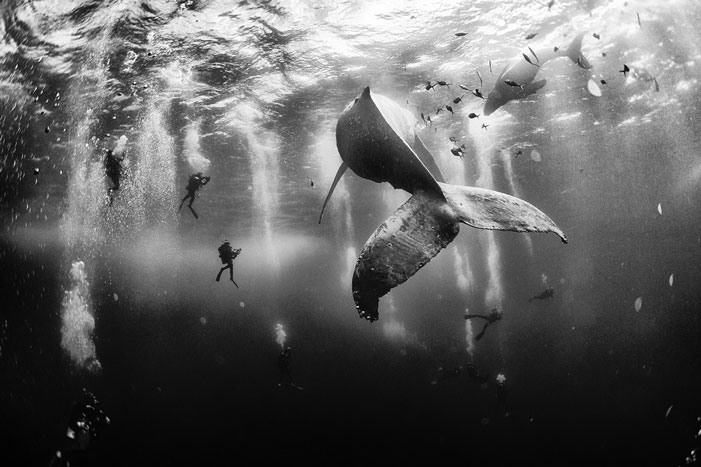The recent National Geographic Travel Contest, edition 2015, made me think. How come that the first prize of such a certainly prestigious contest goes to a black-and-white photograph, a photograph of divers swimming near a humpback whale off the western coast of Mexico. What a capture. The winner a black-and-white image; this in the days of ultimate sensor performance with state-of-the-art color rendition and close-to-real dynamic range. Wow. Goes without saying: to this day there is something to black-and-white photography that its color equivalent cannot touch. Color can be distractive. Black-and-white images, however, seem to focus on the whole composition, like adding a different, more dramatic, more authentic dimension, not least because our brain interprets gray shadows and tones differently from what we think we “really” see. But what exactly makes a black-and-white photo a prestigious winner in 2015?

The question whether to shoot color like everyone does or black and white is a dogmatic one. Doesn’t necessarily have to be a Leica M Monochrom Typ 246 to shoot colorless, or does it. One of the beauties of black-and-white photography is its simple highlighting of key features in a photograph, such as a face’s characteristics, a mood, and then it doesn’t matter much whether you’re able to reproduce the complete scales of gray with a camera, a desire which would directly be linked to the color of your money, ego and lack of technique with less esoteric gear.
Any camera can shoot black-and-white, or else use the myriad of options post-processing provides. But it takes some courage these days to “develop” images in gray shades and tones only; to say no to beautiful blue skies and azure oceans, to the perfect skin tone or that golden hair.
I would reckon, however, a good black-and-white picture lets you see the colors. Even more so, every good picture can easily be converted into a not less good black-and-white picture. But not every good black-and-white image can be converted into a good color image. Technically it’s a no-brainer, done by the click of a button. Again. Color often distracts. If not well balanced, color risks distracting the attention.
That’s, of course, generally speaking. Because how bland a world it would be without color photography:

Beautiful color photography, isn’t it. A perfect composition. 10th prize in the National Geographic contest. It’s all relative of course. Yet what does it truly mean that a photo without colors wins such a prestigious contest; a photo, on top of that, that’s shoot in the deep blue ocean and begs to be taken in color.
Why?
Might be that it’s not the photograph that’s black-and-white or colored. It’s our mind making it whatever way. And without doubt black-and-white photographs in general engage the mind differently. Black-and-white photography is more timeless, more dramatic, with a tendency to distance the subject/object matter from reality.
Color is the “reality,” monochrome makes us pause and look more closely. Removing color from a picture helps the viewer to focus on a subject’s/object’s emotional state.
Or as someone once said:
When you photograph people in color, you photograph their clothes. When you photograph people in black and white, you photograph their souls.
Color is just one of the elements in a photograph.
In color you state.
In black and white you suggest.
That might explain some of black-and-white photography’s inherent magic.


